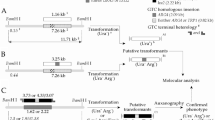Abstract
Gene targeting by homologous recombination occurs in Saccharomyces cerevisiae efficiently when there are as few as 30 base pairs of sequence homology at both ends of the targeting construct. Multiple gene disruptions within a single cell are possible using the hisG cassette, which allows recovery of the marker but leaves a single hisG sequence imbedded in the disrupted gene(s). We use an integration hisG construct, which has limited homology to the target at one end, to show that a single genomic copy of hisG decreases the percentage of integration at the target locus from 44% to 4.5% and two genomic hisG copies decrease it to less than 1%. Enlarging the homology at the disruption construct abolishes this effect. Thus competition between endogenous hisG sequences and successive hisG cassette transformations occurs if there is limited homology at one end of the targeting construct. Therefore, methods using limited homology, such as PCR-mediated gene targeting, are inefficient when significant internal homology exists.
Similar content being viewed by others
Author information
Authors and Affiliations
Additional information
Received: 20 March 2000 / Accepted: 18 July 2000
Rights and permissions
About this article
Cite this article
Davidson, J., Schiestl, R. Mis-targeting of multiple gene disruption constructs containing hisG. Curr Genet 38, 188–190 (2000). https://doi.org/10.1007/s002940000154
Issue Date:
DOI: https://doi.org/10.1007/s002940000154




